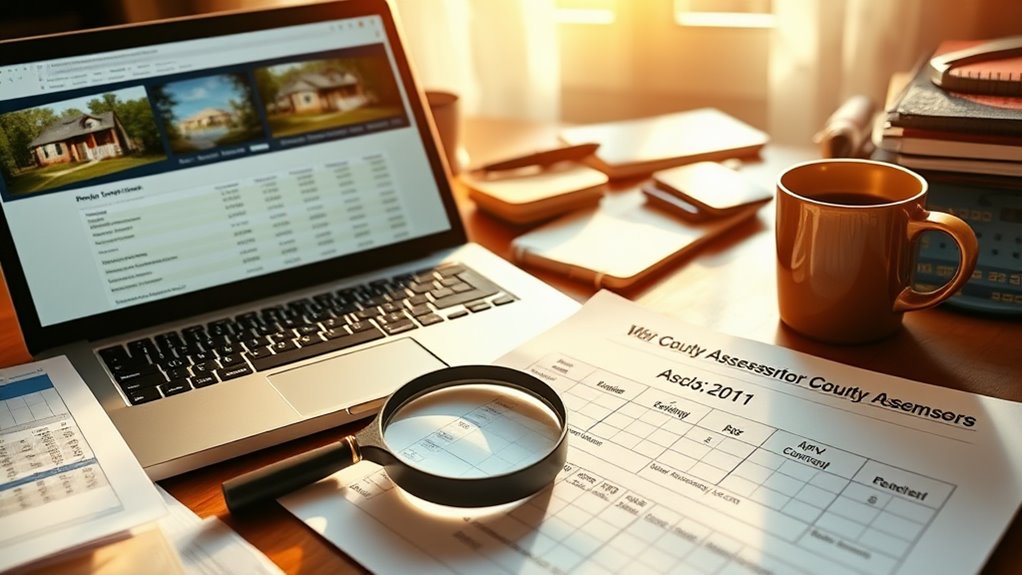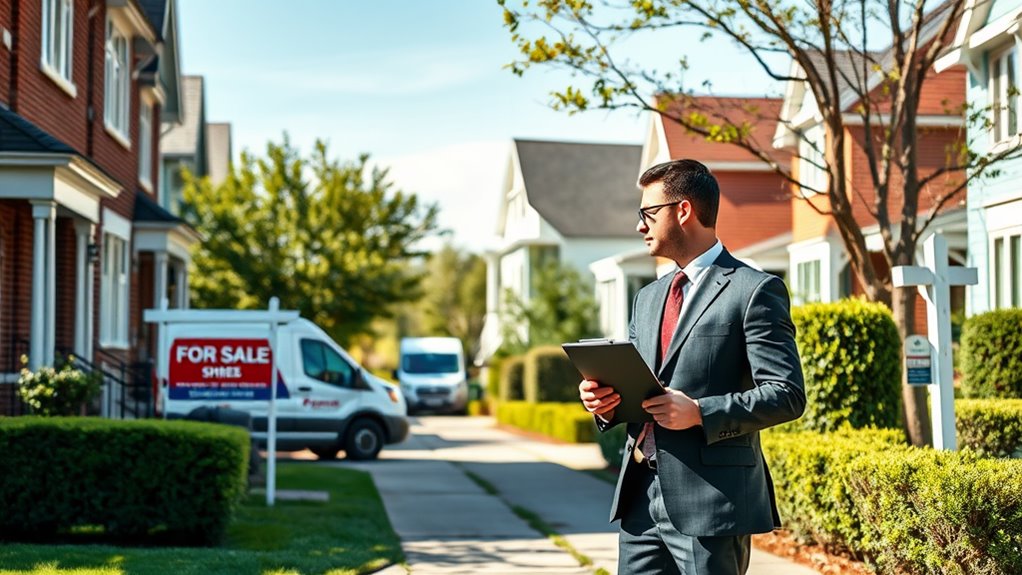To determine ARV for wholesaling success, start by analyzing comparable sales within a 1-mile radius, focusing on size, condition, and features. Use tools like Zillow or Redfin to gather data and cross-check with county assessor records for accuracy. Calculate the average price per square foot and adjust for unique property traits. Apply the 70% Rule (ARV × 70% – repair costs) to set your maximum allowable offer. Refine your approach with market trends to stay competitive and uncover deeper insights.
Key Takeaways
- Use comparable sales (comps) within a 1-mile radius to estimate ARV based on size, condition, and location.
- Calculate average price per square foot from 3-6 recently sold comps to set accurate ARV benchmarks.
- Validate ARV using online tools like Zillow, Redfin, and county assessor data for market consistency.
- Apply the 70% Rule: MAO = ARV × 70% – repair costs to ensure profitability in wholesaling deals.
- Accurately estimate repair costs to avoid overpaying and maintain a 30% margin for fees and unforeseen expenses.
Understanding the Basics of After Repair Value
When evaluating a property for wholesaling, understanding ARV—or After Repair Value—is vital because it determines the property’s potential resale value after repairs. ARV represents the estimated value of a property once all necessary renovations are completed, and it’s pivotal for real estate investors to calculate it precisely to assess profitability. To determine ARV, you’ll need to analyze comparable properties that have recently sold in the same area. These comps should closely match the property regarding size, condition, and location, as these factors directly influence market value. Pay attention to the price per square foot of the comps, as it provides a consistent metric for comparison. By identifying recently sold properties with similar features, you can derive a realistic ARV. This step guarantees you’re not overpaying for the property while maintaining a solid profit margin, aligning with the strategic goals of wholesaling. Additionally, ensure comps are within a 1-mile radius to account for localized market trends and maintain valuation accuracy.
Utilizing Online Tools for Market Value Estimation

After determining ARV through comp analysis, you can enhance accuracy and efficiency by leveraging online tools for market value estimation. Platforms like Zillow, Redfin, and Realtor.com provide detailed insights by analyzing comparable sold listings and recent sales data. Zillow’s “Sold” filter allows you to access up-to-date transactions, helping you refine ARV estimates based on nearby properties with similar features. Redfin’s user-friendly interface offers in-depth comparisons of recently sold homes, securing your calculations align with current market trends. Realtor.com further aids by showcasing active listings and sold properties, giving you a broader perspective on market value. While these tools are invaluable, you should also cross-reference data with county property assessor websites for additional context. For more granular neighborhood desirability metrics, consider using platforms like Mashvisor or Roofstock to assess local rental potential and market trends. By strategically combining these resources, you’ll guarantee your ARV estimates are precise, giving you a competitive edge in wholesaling deals.
Cross-Checking With County Assessor Data

County property assessor data serves as a critical checkpoint for validating ARV estimates in wholesaling. Start by accessing the county property assessor’s website to retrieve the assessed value of the property. This figure provides a baseline for evaluating your ARV calculation’s accuracy. Compare the assessed value to your ARV estimate to identify discrepancies, which can signal overestimations or undervaluations. Verify the assessed value aligns with current market conditions; if it’s outdated, adjust your analysis accordingly. Use the assessed value to strengthen your negotiation leverage when presenting lower offers to sellers. Highlighting discrepancies between the property valuation and your ARV can justify your proposed sales price. This cross-checking process not only validates your ARV but also builds credibility with sellers, demonstrating a data-driven approach. By integrating the county property assessor’s data, you enhance the precision of your ARV estimates, confirming they’re grounded in reality and optimized for successful deals. Additionally, reviewing zoning regulations in the county assessor data can provide insights into permissible land uses, further refining your ARV estimate.
Analyzing Comparable Sales for Accurate ARV

Start by identifying comparable properties that closely match the subject property in size, condition, and location. Evaluate recent sales data from reliable platforms to calculate a precise average price per square foot for these comps. Adjust your ARV estimate by factoring in market trends and unique property features to guarantee it reflects current conditions accurately. Ensure your ARV calculation accounts for unforeseen expenses to avoid inflated estimates and potential financial losses.
Identifying Comparable Properties
When evaluating a property’s After Repair Value (ARV), you’ll need to identify 3-6 recently sold comparable properties that share key characteristics such as size, condition, age, and location to confirm accuracy. Start by searching the multiple listing service or platforms like Zillow and Redfin for properties that sold within a one-mile radius of the subject property. Focus on those with similar features, like square footage and lot size, and verify they sold within the last 3-6 months to reflect current market conditions. You can organize your findings using a table to compare key details:
| Property | Price/Sq. Ft. |
|---|---|
| Comp 1 | $200 |
| Comp 2 | $210 |
| Comp 3 | $195 |
This approach secures a strategic, data-driven ARV estimation. For even more precise insights, consider using PropStream’s comparable sales feature to enhance your property valuation accuracy.
Evaluating Recent Sales Data
To accurately assess the After Repair Value (ARV) of a property, you’ll need to evaluate recent sales data by analyzing comparable properties that mirror the subject property’s key attributes. Start by identifying 3-6 recently sold properties within a 1-mile radius or the same neighborhood, making sure they align in size, condition, and features. Focus on sales from the last 90 days to capture current market trends. Calculate the average price per square foot of these comps for ARV calculation, then multiply it by the subject property’s square footage to establish a baseline ARV. Refine the estimate by adjusting for unique factors like upgrades or lot size that differ from the comps. This method guarantees your ARV reflects accurate, data-driven insights for wholesaling success. Additionally, incorporating historical data analysis into your evaluation can help identify patterns and forecast future market movements, further enhancing the accuracy of your ARV estimate.
Adjusting for Market Trends
While evaluating recent sales data provides a foundational ARV estimate, analyzing comparable sales through the lens of current market trends sharpens the accuracy of your valuation. Market trends, such as rising demand or shifting interest rates, directly impact the value of a property. Use real estate comps to identify patterns in pricing, but adjust for factors like seasonal fluctuations or neighborhood developments. A comparative market analysis helps you determine whether the current value aligns with the future value potential. Incorporate these insights into your ARV calculator to refine your projections. By staying attuned to market dynamics, you’ll guarantee your ARV reflects both the present conditions and anticipated shifts, positioning you to make informed, strategic decisions in wholesaling. Additionally, consider rent-to-price ratios between 0.7% and 1% to ensure your ARV aligns with strong cash flow potential and rental demand.
Applying the 70% Rule for Maximum Allowable Offer

Since determining the maximum allowable offer (MAO) is essential in wholesaling, the 70% Rule provides a structured approach to secure profitability. This percent rule confirms you maintain a 30% margin to cover holding costs, fees, and unforeseen expenses. To apply it effectively, start by calculating the ARV of the property using the ARV Formula, which often includes analyzing comparable properties and the average price per square foot in the area. Next, subtract estimated repair costs and your wholesale fee from 70% of the ARV to find your MAO. For example, if a property’s ARV is $100,000 and repairs are $20,000, your MAO would be $50,000. Accurate estimates are critical; overestimating ARV or underestimating repairs can erode profits. Additionally, consider the price-to-rent ratio to ensure the property aligns with market standards and investment viability.
Consider these steps:
- Calculate ARV using comps and average price per square.
- Deduct repair costs and fees from 70% of ARV.
- Verify precise estimates to avoid overpaying in real estate investing.
Adjusting Strategies for Competitive Markets

To stay competitive, you’ll need to adjust your pricing strategy based on market-driven data, ensuring your MAO aligns with buyer expectations while maintaining profitability. Analyze buyer interest by identifying trends in recent sales and focusing on properties with features or locations that attract higher demand. Use this insight to justify your offers and position your deals as low-risk, high-return opportunities for investors.
Market-Driven Pricing
When operating in competitive markets, adjusting your maximum allowable offer (MAO) to 65%-70% of the after-repair value (ARV) guarantees you remain appealing to buyers while safeguarding profitability. To refine your pricing strategy, analyze recent sales data and comps to identify trends, such as higher demand in specific neighborhoods. This allows you to adjust your ARV estimates and align with market value fluctuations. Use tools like Zillow or Redfin to monitor these changes and stay competitive. Additionally, consider buyer behavior, such as their willingness to invest in renovations for rental income, to confirm your pricing aligns with their goals.
- Leverage comps: Compare similar properties to set accurate ARV benchmarks.
- Monitor demand: Identify high-demand areas to justify pricing adjustments.
- Align with buyer goals: Tailor pricing to match buyer investment strategies.
Buyer Interest Analysis
Understanding buyer behavior is critical to refining your pricing strategies in competitive markets. Analyze recent sales and rental income potential to align your investment property pricing with buyer goals. Focus on properties requiring minimal estimated repair costs, as these appeal to buyers seeking quick returns or a fix and flip opportunity. Use the rule of thumb of ARV minus repair costs to calculate a maximum offer price that attracts interest while ensuring profitability. In desirable neighborhoods, buyers may pay higher prices, so adjust your real estate deal pricing accordingly. Offering properties at 65%-70% of ARV can make your deal more competitive. Leverage market trends to negotiate effectively, ensuring your offers align with buyer expectations and demand.
Conclusion
To nail your ARV, think of it as a puzzle: each piece—online tools, assessor data, and comps—must fit perfectly. Sharpen your strategy by applying the 70% rule, but stay agile; in competitive markets, precision is your edge. Like a seasoned chess player, anticipate moves, adjust tactics, and strike with confidence. Master this, and you’ll open the door to wholesaling success, turning potential into profit with every calculated step.




